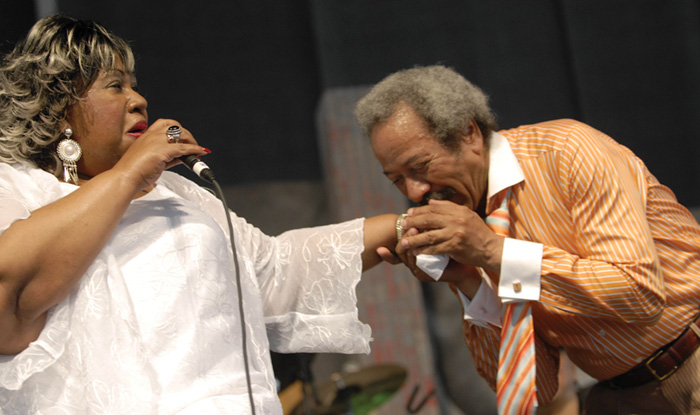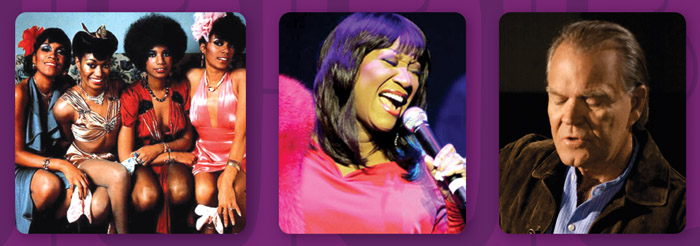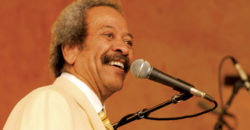Yes He Can Can: Allen Toussaint perpetuates New Orleans’ unique musical style
Published: November 12, 2015
Last Updated: September 1, 2016
by Kathy Finn
Editor’s Note: Allen Toussaint, the versatile producer, songwriter, pianist and singer who, for more than six decades, shaped music in his hometown of New Orleans and far beyond, died on Nov. 10, 2015, following a concert in Madrid. He was 77. In the Summer 2010 edition of Louisiana Cultural Vistas, journalist Kathy Finn wrote about Toussaint’s remarkable career—one that continually inspires countless fans and fellow musicians the world over.
Kids who grow up in music-loving families often retain strong memories of the tunes they heard at home. If they are lucky, their early experiences instill in them a love of music that will last through their lives. If they are really fortunate, the sounds they absorb in the formative years awaken a God-given talent that drives a lifetime of musical expression.Something along that line occurred in the early life of Allen Toussaint. Like many others who were born and raised in New Orleans, he heard music coming from every direction during his childhood. In his parents’ home it was standards of the time — Ray Charles’ “I Wonder Who’s Kissing Her Now,” for instance — along with the symphonic music and opera that his mother loved. The streets in those days echoed with sounds of rising pop artists, such as Fats Domino singing “Ain’t That a Shame.” On the radio, The Clovers crooned tunes like “One Mint Julep,” while New Orleans native and gospel star Mahalia Jackson wowed listeners with her “Amazing Grace.” Through it all, a hybrid music that would evolve into rockabilly reverberated from a hot Shreveport radio show called the Louisiana Hayride.

Allen Toussaint and Irma Thomas in performance. Photo by Cheryl Gerber
The young Toussaint took it all in. Like many of his friends, he aspired to play and sing the big songs of his day, and he became skilled at mimicking the stylistic inflections of the originals. But at a young age he discovered that, in addition to his affinity for the piano, he had other talents that not all his friends could claim.
“My mother had bought an Emerson record player, and they gave her two albums to go with it. One was classical and included Edvard Grieg’s ‘Piano Concerto.’ The other was an album of standards by Benny Goodman and Woody Herman,” he says. “There was a Benny Goodman song called ‘Love Walked In,’ and I heard the most beautiful trombone duet in the middle of that song. For some reason it made me want to try my hand at writing.”
At age 12, he decided to write a duet for trombone and trumpet, “because that is what I had heard.” In typical fashion, he attempted to school himself in both instruments.
“I bought the beginner’s books to see what is the lowest and highest note the horns can hit. I did that with all the instruments I wrote for, so I could be sure I was writing within their range.” Each new experience led him to more writing and, later, arranging.
Slow learner
What Toussaint didn’t realize during his early years of duplicating the sounds he heard on the radio and jukeboxes, was that his family’s piano was at least a half-step out of tune with the recorded music. So as he reproduced the day’s popular songs on the piano, he was actually playing them in a different key than they were originally written.
That reality didn’t dawn on him until one day when he took a closer look at the Grieg concerto he had learned to play by listening to his mother’s album. “I pretty much learned it all in B-flat minor,” Toussaint says. “It wasn’t until I was a teenager that I realized the full title was ‘Piano Concerto in A Minor.’”
In 2009, recording artist and songwriter Elvis Costello took note of Toussaint’s unusual transcription skills in an interview he did with Toussaint on National Public Radio.
“All jazz musicians transcribe things, but you were absorbing them by ear and playing them in another key, and at the same time you were playing those unique rhythms of New Orleans that have maybe two or three different threads going on,” Costello said. “What made you want to play these things?”
The soft-spoken Toussaint answered with characteristic candor: “I didn’t know how different it was from the rest of the world.”
Even now he recalls that what motivated him, musically, in his early days was his belief “that everybody else already knew how to play all the music I was hearing.” Certain that he was a slow learner, he scrambled to hear and reproduce every kind of music imaginable. But it was the local musicians he heard who inspired him the most.
Toussaint remembers the jolt he felt the first time he heard Professor Longhair play tunes like “Hadacol Bounce” and “In the Night.” The one that really knocked him out, though, was Longhair’s iconic “Tipitina,” which would become something of an anthem for Carnival time in New Orleans. Toussaint was mesmerized by the unusual syncopation in the tune and the fancy “ornamentation” of the right hand. He practiced until he could replicate the technique, just as he mimicked the other great New Orleans players who helped define local piano — Jelly Roll Morton, Tuts Washington, Henry Butler and the young James Booker. Toussaint retains a particular fondness for Booker.
“In my time, James Booker was the ultimate,” he says. “I met him when he was 12 and I was 13. He had broken his arm and had a cast on his arm, but he sat down at a piano and played a Bach three-part invention. It was just amazing.”
As the two grew into adulthood, Booker veered into a loose lifestyle that would lead him to an early death in 1983, but the two piano players remained friends to the end. “Booker was in a class by himself,” Toussaint says.
Hillbilly music
Back in the day, Toussaint, too, was on his way to becoming a singular talent, though he didn’t realize it. He was too busy not only copying the sounds he heard around him, but collaborating with peers, some of whom would, themselves, one day become stalwarts of the New Orleans music scene.
Many afternoons after finishing the school day at Booker T. Washington High School, kids would gather in the front room of the Toussaint family’s Gert Town home. Toussaint would sit at the piano surrounded by friends like Ernie K-Doe, Irma Thomas, Aaron Neville, Willy Harper, Benny Spellman and Snooks Eaglin, all with their own musical aspirations. “They would come by the house and want me to write songs for them, and I would,” he says.
“In the very early days we listened to a lot of Fats Domino and such, but I also heard a lot of ‘hillbilly’ music,” Toussaint says, recalling some of the early country tunes that veered toward rock ‘n’ roll, a la Jerry Lee Lewis. “I loved that music because it had those saloon pianos with a lot of ‘trilling,’ so it sounded like a lot was happening,” he recalls.
That comment comes as no surprise to folklorist and Tulane University professor Nick Spitzer, who credits artists such as Toussaint and his New Orleans predecessors with understanding better than many other musicians how much sound they could get from a piano.
“With that one instrument, they could do rhythm and melody and have total entertainment,” he says. “They were capable of playing ragtime, early forms of jazz, spiritual, boogie-woogie, blues, and they evolved toward a kind of piano jazz a la New Orleans that included light classical music in some cases, as little riffs.”
Spitzer, who produces and hosts the weekly public radio show “American Routes,” says it was this core group of artists who came to define the unique New Orleans piano sound. “They became masters of their instruments, and the idea of a piano professor emerged with those men,” he says. “The tension between African and European influences is profound in these piano players, and Toussaint is right in the middle of it.”
Growing up in a Creole family that embraced classical music but also loved “black vernaculars,” Toussaint became an almost uniquely endowed player, composer and producer, Spitzer says.

After performing a duet, Allen Toussaint kisses singer Marva Wright’s hand at the 2007 New Orleans Jazz and Heritage Festival. Photo by Cheryl Gerber
In the genes
Certainly, music was in Toussaint’s bloodline. His mother’s maiden name was Neville — even in his early days a recognized name in local music. His father, Clarence, played the trumpet and occasionally performed professionally with a local band. Toussaint’s older brother Vincent played the guitar, and when Toussaint “discovered” the instrument he was destined to play, he was barely out of kindergarten.
The upright piano delivered to the Toussaint home in the early 1940s initially was intended not for Allen, but for his older sister Joyce. Genteel families of the time considered it dignified for a young lady to play the piano, and the Toussaints wanted their daughter to learn. They didn’t anticipate how their youngest child would react.
“I remember the night they brought it in, this big piece of furniture,” Toussaint recalls. “I walked over to it and touched it, and it gave this beautiful sound. I loved it immediately.”
Toussaint’s sister was amazed at how quickly he taught himself to play — hearing a song and almost immediately reproducing it on the piano without reading any music. Gradually, as she learned to read music, she shared her knowledge with him, giving him some of the tools he would need when he would later begin composing music in earnest.
His family may have thought that the young Toussaint was headed for a performing career, and to some extent he was. But as much as he enjoyed playing the piano, as time went on, he tended to shun the performance stage in favor of behind-the-scenes work as a writer, producer and arranger.
Longtime New Orleans music writer Ben Sandmel says Toussaint’s skills in those area probably brought him greater national recognition than some other popular local musicians. “Allen Toussaint is associated with a lot of big hits, and he’s worked with a huge number of major musicians,” Sandmel says. “People who know music know his track record.”
Sandmel says Toussaint’s reputation as a writer and producer took off with hits like Ernie K-Doe’s “Mother-in-Law” and Lee Dorsey’s “Ride Your Pony.” In 1962, Benny Spellman made waves with his recordings of Toussaint’s “Lipstick Traces” and “Fortune Teller.” Both songs would spawn covers by countless later bands, from The Rolling Stones to The Who.
While Toussaint started out writing singularly New Orleans-sounding tunes, as time went on his compositions began to reflect the range of his musical experiences. In 1964, he came up with pop instrumental “Java,” which trumpeter Al Hirt turned into a Grammy-winner. The next year Toussaint scored with another trumpet sound, composing the song “Whipped Cream.” Big-band star Herb Alpert turned it into a hit, and the piece later became the theme for the TV show “The Dating Game.”
Toussaint’s off-stage talents began to crystalize in a big way in the mid-1960s, when having wrapped up a two-year stint in the Army, he dived back into the music business in New Orleans. It was around this time that he teamed up with fellow producer Marshall Sehorn to found Sea-Saint Studios in Gentilly. In almost no time, the studio became a hub for hits and a second home for iconic local performers like The Meters, the Neville Brothers and Dr. John, who recorded “Right Place Wrong Time” there in 1973.
As Toussaint’s work made waves nationally, more big performers came calling. Stars from Otis Redding, Solomon Burke and Robert Palmer to The Yardbirds and The Band embraced him. In 1974, he produced the blockbuster “Lady Marmalade” for Patti Labelle. Later he collaborated with Paul McCartney on the Wings album “Venus and Mars.”
The broad appeal of Toussaint’s compositions remains stunning by comparison to many song writers. Take the song “Southern Nights,” for example. As he originally wrote it, the song was a gentle reflection of his memories from weekends spent visiting his relatives in rural Louisiana. But in 1977 singer and guitarist Glenn Campbell saw other potential in the tune. He picked up the tempo, added some fancy guitar riffs and sang it on his popular TV show. “Southern Nights” soared to No. 1 on Billboard’s country, pop and adult contemporary charts.
Sandmel says it’s notable that not only did Toussaint work with “a huge number” of talented musicians over the decades, but he continues to write and perform today, and his phone continues to ring.
“He’s still in peak form and very much in demand,” Sandmel says. “He has a thriving career and is doing a lot of different things. Rather than just getting up there and playing hits from decades ago, he’s an ongoing, vital, creative musician.”
The music world formally recognized that fact in 1998 when Toussaint was inducted into the Rock ‘n’ Roll Hall of Fame. Meanwhile, his music continues to find new life. In 2007, Toussaint’s “Fortune Teller” surfaced yet again in a rendition by Robert Plant and Alison Krauss on their Grammy-winning album, “Raising Sand.”
Jewel in the crown
Anyone who has met Toussaint can attest that, despite his recognition and success, he remains largely the same gentle-spirited person who gamely wrote songs for his friends decades ago. Chances are, that is part of what accounts for his musical longevity.
“He’s a very personable guy,” Sandmel notes. “He’s very pleasant to be with, and he’s not a temperamental artist. That counts for a lot.”
That image may have been helpful to Toussaint in the dark days of late 2005. Like most of the rest of his Gentilly neighborhood, Toussaint’s home was all but destroyed by the flood that followed Hurricane Katrina. He stayed in the city for a time, but later fled to New York to try to get some work done. He began performing right off the bat, at benefit concerts for New Orleans organized by East Coast artists in Madison Square Garden and elsewhere.
It was through those concerts that he renewed his acquaintance with Elvis Costello, who suggested that the two collaborate on a recording. The result was a veritable songbook of Toussaint compositions, an album called “River in Reverse.”
“We started recording it in Hollywood, because New Orleans was still not in shape yet,” Toussaint says. But then we came and finished it off in New Orleans, at Piety Street Studios in the Ninth Ward. It’s a lovely studio, and it was right as rain to be there.”

Numerous artists made Allen Toussaint songs chart-topping hits: The Pointer Sisters (“Yes We Can Can,” 1973), Patti Labelle (“Lady Marmalade,” 1974), and Glen Campbell (“Southern Nights,” 1977).
In 2009, Toussaint teamed up with producer Joe Henry on yet another new album, “Bright Mississippi.” In this departure from his previous work, Toussaint “re-imagines” classic jazz pieces originally made famous by New Orleans jazz greats Jelly Roll Morton, Sidney Bechet and Louis Armstrong, among others.
Such examples of returning to his roots help explain why scores of acclaimed musicians recognize Toussaint as a powerful force in helping to perpetuate New Orleans’ niche in music history, even as he stretches into new musical territory. Some worry, though, that future generations may not offer up the type of musical artist who can help sustain distinctive local styles.
Dr. Michael White, an accomplished clarinetist, recording artist and professor at Xavier University in New Orleans, says the growing popularity of New Orleans as a music center has both up- and down-sides. While being a musical magnet brings greater exposure to the area’s abundant talent, it can also have a homogenizing effect on local sounds.
“We’ve always heard the complaint that local musicians had to go somewhere else in order to be recognized and make music that would be popular, but that kind of isolation is also what allowed the city to have its own sound,” White says.
New Orleans is “one of the last places” where you can still hear and recognize music as being local,” he says. But as more people from elsewhere become interested in these sounds, and as local musicians combine what they’ve learned at home with what they pick up from others, New Orleans music may become less distinct.
Big music events such as the New Orleans Jazz and Heritage Festival contribute to the phenomenon, drawing widespread attention to native music while stimulating local musicians’ interest in new sounds.
All of this tends to make Allen Toussaint seem a still more precious jewel in the city’s musical crown. But Spitzer, for one, would argue that Toussaint all along has represented a blend of many sounds that accumulated around his New Orleans style.
“His understanding of New Orleans music has touched popular hits from New Orleans and popular performers from elsewhere who wanted that sound,” Spitzer says. “He’s infused the writing of important songs and the arranging of important hits. He’s really able to operate in a lot of settings.”
Toussaint says he intends to continue doing so. “I’m constantly writing, and of course, I’m giggin’, and I’m actually enjoying it,” he says. “It’s kind of surprising because I’m not so much about being center-stage. I’d actually rather be a sideman — but this works.”
—–
Kathy Finn is a New Orleans-based freelance writer and editor specializing in business news reporting for Thomson Reuters, CNN Money, and Fortune Small Business, among other clients.
